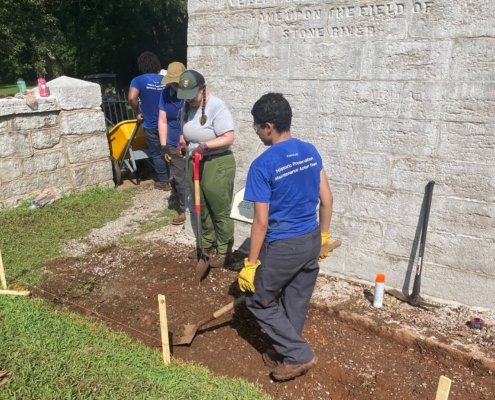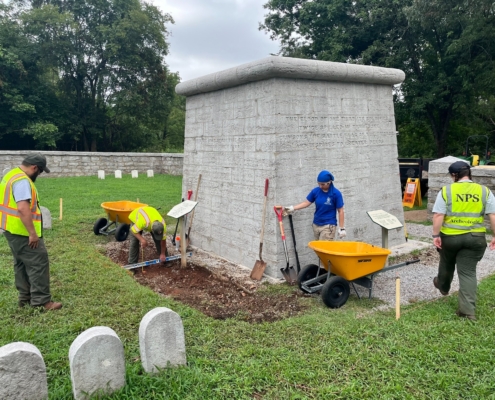Adapted by Emma Fantuzzo from a report written by Ilana J. Smith, SCA Crew Leader, with approval from the Student Conservation Association.
About the CPA Team:
With support from the National Park Foundation, the Corps Project Assistance (CPA) Team was created in 2022 by The Corps Network to aid the National Park Service (NPS) in scoping and creating cost estimates for facility-related projects at small and medium-size parks across the country. These parks often lack the staff capacity and funding to undertake the work on their own. The projects, which are funded through the Great American Outdoors Act, are meant to be carried out by crews consisting of NPS staff and Service and Conservation Corps members.
The CPA Team has scoped projects across the country, several of which have been completed. Among other locations, the finished work includes historic preservation projects at Camp Nelson National Monument, Andrew Johnson National Historic Site, Abraham Lincoln Birthplace National Historic Park, and Stones River National Battlefield.
Stones River National Battlefield (STRI) Cemetery is one of fourteen National Cemetery sites the National Park Service manages. Partnering with the Student Conservation Association (SCA), the site was cleaned and restored to maintain the sanctity of this historic resting place.
About the Project:

SCA Members at Stones River National Battlefield
SCA members worked with staff from STRI to preserve and renovate the site to be more accessible for future generations. Over the course of two months, the team cleaned approximately 800 headstones of Civil War and World War I and II soldiers. They also made ADA compliance renovations to the walkway for the Hazen Brigade Monument, the oldest Civil War monument still standing in its original battlefield location. In addition, the team was able to assist with smaller maintenance projects, including removing invasive Kudzu and Honeysuckle.
Through the project, the SCA team learned the history of the site and its significance to American History and the liberation of African Americans from slavery. Within the cemetery lay the remains of several members of the United States Colored Troops, Union Army regiments during the Civil War that primarily enlisted African American soldiers. The Stones River battle was instrumental in bringing the Union to victory and the region became a place where persons freed from enslavement settled down. As SCA Crew Leader Ilana Smith noted, there is a sign only 100 yards from the Hazen Brigade Monument acknowledging a post-Civil War freed person community called Cemetery that developed near the battlefield.
Conservation Impact:
The purpose of SCA’s work at STRI was to maintain the NPS lands at the battlefield. The project expanded to include maintenance of the main cemetery, renovation of the monument pathway, and removal of invasive species. Other conservation efforts included the removal of trash from a storm that had taken place a few months prior, and building 60 feet of cedar fencing.
Some of the crew’s accomplishments in numbers include:
- Approximately 800 headstones at main cemetery cleaned
- Approximately 72 feet of walkway around Hazen Brigade Monument renovated and improved
- 20 feet of cedar fence built at the parking lot of Fortress Rosencrans
- Approximately 40 feet of cedar fence re-built on the west side of Nashville Highway
- Approximately 883 invasive plants (Honeysuckle and Kudzu) manually removed
- 100 pounds of trash removed

Corpsmember Impact:
The SCA crew took several field trips to gain a better understanding of the history and community in the area. This included trips to historic Civil War sites, local farms, and several museums. This helped the crew build an appreciation for the work they were doing and how it affected the people of the community.
Several Corpsmembers took the opportunity to speak with NPS staff about their careers and explore future career opportunities. Three of the members became UTV certified which helped the team to more efficiently complete work. All members gained more skills in construction and maintenance. One Corpsmember noted, “I feel like we are walking away from Stones River with not just professional connections, but with friends and mentors too.”






































































